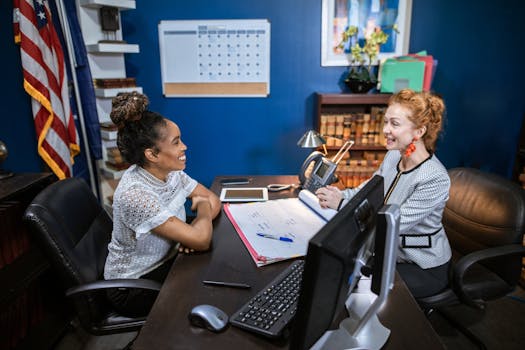Career advice
Mastering Virtual Interviews: Your Path to Success in South Africa
Prepare for virtual interviews with our practical tips that boost your confidence and help you shine. Learn to navigate this new job market successfully.
Advertisement
In the evolving job market, virtual interviews are becoming increasingly common, especially in South Africa. Preparing well can set you apart and boost your confidence. Understanding the nuances of this format is essential for success.
With the right approach and preparation, your virtual interview experience can be smooth and rewarding. As employers adapt to digital platforms, candidates must also refine their skills. This article provides practical tips on preparing for virtual interviews.
From testing technology to body language and communication skills, each element plays a role in your performance. Let’s explore how to ensure you’re ready to impress during your upcoming virtual interview.
Understanding the Virtual Interview Format
Virtual interviews differ significantly from traditional in-person meetings. They rely on technology, and familiarizing yourself with the format can alleviate anxiety. Understanding what to expect is the first step to success.
Typically, virtual interviews take place via video conferencing platforms. Recognizing the tools your employer uses can save you from last-minute technical issues. Popular platforms include Zoom, Microsoft Teams, and Google Meet.
During a virtual interview, you’ll need to engage and connect remotely. This format may present unique challenges such as potential distractions at home. Preparing your environment can make a significant difference.
It’s essential to ensure that your internet connection is stable and reliable. A poor connection can disrupt communication and distract you from expressing your qualifications. Testing your equipment is an easy preventative measure.
Finally, remember that the virtual interview format includes subtle tabs like lighting and background choice. Next, we’ll discuss how to prepare your technological setup effectively.
Setting Up Your Technology
Before your interview, double-check all technological components. Start by ensuring your computer, webcam, and microphone are functioning correctly. This step can save you valuable time on the day of the interview.
Updating your video conferencing software is another important aspect. Outdated software can cause glitches, leading to distractions or delays. Familiarize yourself with the platform so you can navigate it smoothly.
Next, conduct a technical rehearsal. This step involves testing audio and video quality with a friend or family member. Their feedback will help you identify and address any unexpected issues.
Poor lighting can affect how you present yourself. Make sure you’re well-lit from the front; natural light works best. Avoid backlighting, as it can make you appear shadowy or unclear during the interview.
Finally, consider your background. A tidy, neutral background is best to minimize distractions. Use professional appearance to set a positive tone even before the interview begins.
Preparing Your Environment
Creating the right environment for your interview is crucial for your performance. A quiet room with minimal distractions ensures you can focus completely on the conversation. Prioritizing this aspect can enhance your overall presence.
Notify housemates of your interview schedule. This arrangement helps minimize interruptions, allowing you to engage fully. Communicating your needs conveys professionalism and enhances preparedness.
Incorporating comfortable furniture can aid your concentration. Use a supportive chair and ensure your workspace is uncluttered. This adjustment can help you remain comfortable throughout the interview.
Consider having water close by to stay hydrated. Staying composed can help you manage nervousness. A sip of water can also offer you a moment to gather your thoughts if needed.
In summary, establishing your environment thoughtfully can facilitate a smoother interview. Focus on eliminating distractions and ensuring comfort to help you shine during your virtual meeting.
Researching the Company
Understanding the company you’re interviewing with is vital. Familiarize yourself with their mission, values, and recent news. This knowledge can enhance your answers and resonate with the interviewer.
Look into the company’s culture and work environment as well. Tailor your responses to align with their values, demonstrating you’re a good fit. Highlighting your compatibility can set you apart from other candidates.
Review the role’s job description thoroughly before the interview. Identify key responsibilities and the skills required. Prepare examples from your experiences that demonstrate your ability to fulfill those duties.
Utilizing social media platforms, such as LinkedIn, can offer insights into current employees’ experiences. Engaging with their content might provide further understanding and ways to connect during the interview.
Lastly, prep insightful questions about the company. This strategy shows your engagement and enthusiasm. Asking relevant questions can improve your dialogue and showcase your genuine interest.
Dressing Professionally
Even in a virtual format, your appearance matters. Dressing professionally conveys respect for the interview process and the organization. Choose attire similar to what you would wear for an in-person interview.
Researching the company’s dress code helps; this insight can guide your outfit choice. Opting for professional clothing creates a first impression, even if seen only from the waist up.
Focus on solid colors, which tend to look best on camera. Busy patterns can be distracting and may not translate well on screen. Prioritize simplicity to project professionalism.
Before the interview, consider how your outfit looks on camera. A quick video test can confirm that your attire appears polished and appropriate. Making small adjustments enhances your overall appearance.
Finally, cleanliness and grooming remain important. Neat hair and understated accessories contribute to a positive impression. Prepare to present yourself in the best light possible.
Practicing Your Communication Skills
Effective communication is key in any interview, and virtual formats require some additional considerations. Clear verbal communication helps you articulate thoughts without confusion. Practicing this ahead of time can bolster your confidence.
Use a conversational tone while maintaining professionalism. Focus on speaking clearly, and avoid filler words. A strong command of language will help convey your qualifications more persuasively.
Pay attention to your body language as well while on camera. Maintain eye contact by looking into the camera rather than the screen. This small adjustment creates a connection with your interviewer.
Prepare concise answers using techniques like the STAR method (Situation, Task, Action, Result). This structure helps you provide structured and appealing responses to interview questions.
Finally, consider recording a mock interview. Reviewing your performance allows you to identify strengths and areas needing improvement. This feedback cycle can strengthen your communication skills before the actual interview.
Following Up After the Interview
The interview may be over, but your efforts should not stop there. Sending a follow-up email expresses gratitude and reiterates your interest. This simple step reinforces your enthusiasm and professionalism.
Ideally, send this email within 24 hours of the interview. Mention specific points discussed during the chat, reaffirming your alignment with the company’s goals. Personalizing your message leaves a positive impression.
Incorporate any relevant details you might have forgotten to mention during the interview. This addition can further showcase your enthusiasm and commitment to the position.
Don’t hesitate to inquire about the next steps in the hiring process. This question illustrates your eagerness while providing you with helpful information. Understanding timelines can ease anxiety while waiting for a response.
Overall, a follow-up message can turn a successful interview into a memorable one. This practice can distinguish you from other candidates also vying for the same role.
Conclusion
Preparing for a virtual interview requires a combination of technical, environmental, and personal elements. By understanding the format, setting up technology, and dressing appropriately, you can build confidence.
Researching the company and practicing communication skills are crucial components, as is following up after the interview. Each area contributes to creating a comprehensive approach for success.
With careful preparation, your virtual interview can be a seamless experience. Use these insights as a guide to showcase your qualifications and secure the job you desire.





